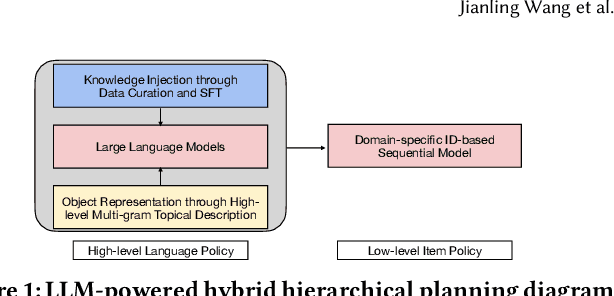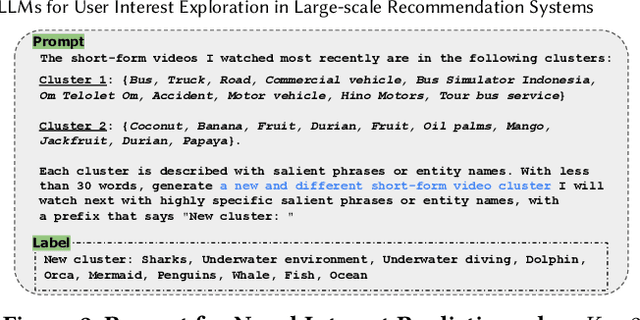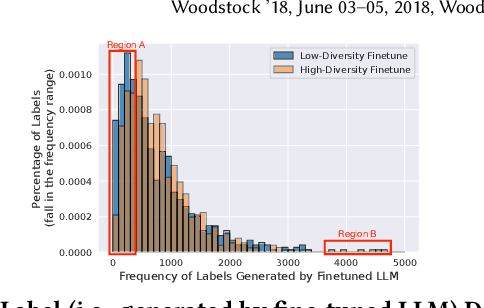Yueqi Wang
Peter
PLUM: Adapting Pre-trained Language Models for Industrial-scale Generative Recommendations
Oct 09, 2025Abstract:Large Language Models (LLMs) pose a new paradigm of modeling and computation for information tasks. Recommendation systems are a critical application domain poised to benefit significantly from the sequence modeling capabilities and world knowledge inherent in these large models. In this paper, we introduce PLUM, a framework designed to adapt pre-trained LLMs for industry-scale recommendation tasks. PLUM consists of item tokenization using Semantic IDs, continued pre-training (CPT) on domain-specific data, and task-specific fine-tuning for recommendation objectives. For fine-tuning, we focus particularly on generative retrieval, where the model is directly trained to generate Semantic IDs of recommended items based on user context. We conduct comprehensive experiments on large-scale internal video recommendation datasets. Our results demonstrate that PLUM achieves substantial improvements for retrieval compared to a heavily-optimized production model built with large embedding tables. We also present a scaling study for the model's retrieval performance, our learnings about CPT, a few enhancements to Semantic IDs, along with an overview of the training and inference methods that enable launching this framework to billions of users in YouTube.
mRAG: Elucidating the Design Space of Multi-modal Retrieval-Augmented Generation
May 29, 2025Abstract:Large Vision-Language Models (LVLMs) have made remarkable strides in multimodal tasks such as visual question answering, visual grounding, and complex reasoning. However, they remain limited by static training data, susceptibility to hallucinations, and inability to verify claims against up-to-date, external evidence, compromising their performance in dynamic real-world applications. Retrieval-Augmented Generation (RAG) offers a practical solution to mitigate these challenges by allowing the LVLMs to access large-scale knowledge databases via retrieval mechanisms, thereby grounding model outputs in factual, contextually relevant information. Here in this paper, we conduct the first systematic dissection of the multimodal RAG pipeline for LVLMs, explicitly investigating (1) the retrieval phase: on the modality configurations and retrieval strategies, (2) the re-ranking stage: on strategies to mitigate positional biases and improve the relevance of retrieved evidence, and (3) the generation phase: we further investigate how to best integrate retrieved candidates into the final generation process. Finally, we extend to explore a unified agentic framework that integrates re-ranking and generation through self-reflection, enabling LVLMs to select relevant evidence and suppress irrelevant context dynamically. Our full-stack exploration of RAG for LVLMs yields substantial insights, resulting in an average performance boost of 5% without any fine-tuning.
User Feedback Alignment for LLM-powered Exploration in Large-scale Recommendation Systems
Apr 07, 2025Abstract:Exploration, the act of broadening user experiences beyond their established preferences, is challenging in large-scale recommendation systems due to feedback loops and limited signals on user exploration patterns. Large Language Models (LLMs) offer potential by leveraging their world knowledge to recommend novel content outside these loops. A key challenge is aligning LLMs with user preferences while preserving their knowledge and reasoning. While using LLMs to plan for the next novel user interest, this paper introduces a novel approach combining hierarchical planning with LLM inference-time scaling to improve recommendation relevancy without compromising novelty. We decouple novelty and user-alignment, training separate LLMs for each objective. We then scale up the novelty-focused LLM's inference and select the best-of-n predictions using the user-aligned LLM. Live experiments demonstrate efficacy, showing significant gains in both user satisfaction (measured by watch activity and active user counts) and exploration diversity.
Re-Align: Aligning Vision Language Models via Retrieval-Augmented Direct Preference Optimization
Feb 18, 2025Abstract:The emergence of large Vision Language Models (VLMs) has broadened the scope and capabilities of single-modal Large Language Models (LLMs) by integrating visual modalities, thereby unlocking transformative cross-modal applications in a variety of real-world scenarios. Despite their impressive performance, VLMs are prone to significant hallucinations, particularly in the form of cross-modal inconsistencies. Building on the success of Reinforcement Learning from Human Feedback (RLHF) in aligning LLMs, recent advancements have focused on applying direct preference optimization (DPO) on carefully curated datasets to mitigate these issues. Yet, such approaches typically introduce preference signals in a brute-force manner, neglecting the crucial role of visual information in the alignment process. In this paper, we introduce Re-Align, a novel alignment framework that leverages image retrieval to construct a dual-preference dataset, effectively incorporating both textual and visual preference signals. We further introduce rDPO, an extension of the standard direct preference optimization that incorporates an additional visual preference objective during fine-tuning. Our experimental results demonstrate that Re-Align not only mitigates hallucinations more effectively than previous methods but also yields significant performance gains in general visual question-answering (VQA) tasks. Moreover, we show that Re-Align maintains robustness and scalability across a wide range of VLM sizes and architectures. This work represents a significant step forward in aligning multimodal LLMs, paving the way for more reliable and effective cross-modal applications. We release all the code in https://github.com/taco-group/Re-Align.
Train Once, Deploy Anywhere: Matryoshka Representation Learning for Multimodal Recommendation
Sep 25, 2024



Abstract:Despite recent advancements in language and vision modeling, integrating rich multimodal knowledge into recommender systems continues to pose significant challenges. This is primarily due to the need for efficient recommendation, which requires adaptive and interactive responses. In this study, we focus on sequential recommendation and introduce a lightweight framework called full-scale Matryoshka representation learning for multimodal recommendation (fMRLRec). Our fMRLRec captures item features at different granularities, learning informative representations for efficient recommendation across multiple dimensions. To integrate item features from diverse modalities, fMRLRec employs a simple mapping to project multimodal item features into an aligned feature space. Additionally, we design an efficient linear transformation that embeds smaller features into larger ones, substantially reducing memory requirements for large-scale training on recommendation data. Combined with improved state space modeling techniques, fMRLRec scales to different dimensions and only requires one-time training to produce multiple models tailored to various granularities. We demonstrate the effectiveness and efficiency of fMRLRec on multiple benchmark datasets, which consistently achieves superior performance over state-of-the-art baseline methods.
Auto-Encoding or Auto-Regression? A Reality Check on Causality of Self-Attention-Based Sequential Recommenders
Jun 04, 2024



Abstract:The comparison between Auto-Encoding (AE) and Auto-Regression (AR) has become an increasingly important topic with recent advances in sequential recommendation. At the heart of this discussion lies the comparison of BERT4Rec and SASRec, which serve as representative AE and AR models for self-attentive sequential recommenders. Yet the conclusion of this debate remains uncertain due to: (1) the lack of fair and controlled environments for experiments and evaluations; and (2) the presence of numerous confounding factors w.r.t. feature selection, modeling choices and optimization algorithms. In this work, we aim to answer this question by conducting a series of controlled experiments. We start by tracing the AE/AR debate back to its origin through a systematic re-evaluation of SASRec and BERT4Rec, discovering that AR models generally surpass AE models in sequential recommendation. In addition, we find that AR models further outperforms AE models when using a customized design space that includes additional features, modeling approaches and optimization techniques. Furthermore, the performance advantage of AR models persists in the broader HuggingFace transformer ecosystems. Lastly, we provide potential explanations and insights into AE/AR performance from two key perspectives: low-rank approximation and inductive bias. We make our code and data available at https://github.com/yueqirex/ModSAR
LLMs for User Interest Exploration: A Hybrid Approach
May 25, 2024



Abstract:Traditional recommendation systems are subject to a strong feedback loop by learning from and reinforcing past user-item interactions, which in turn limits the discovery of novel user interests. To address this, we introduce a hybrid hierarchical framework combining Large Language Models (LLMs) and classic recommendation models for user interest exploration. The framework controls the interfacing between the LLMs and the classic recommendation models through "interest clusters", the granularity of which can be explicitly determined by algorithm designers. It recommends the next novel interests by first representing "interest clusters" using language, and employs a fine-tuned LLM to generate novel interest descriptions that are strictly within these predefined clusters. At the low level, it grounds these generated interests to an item-level policy by restricting classic recommendation models, in this case a transformer-based sequence recommender to return items that fall within the novel clusters generated at the high level. We showcase the efficacy of this approach on an industrial-scale commercial platform serving billions of users. Live experiments show a significant increase in both exploration of novel interests and overall user enjoyment of the platform.
Linear Recurrent Units for Sequential Recommendation
Oct 03, 2023Abstract:State-of-the-art sequential recommendation relies heavily on self-attention-based recommender models. Yet such models are computationally expensive and often too slow for real-time recommendation. Furthermore, the self-attention operation is performed at a sequence-level, thereby making low-cost incremental inference challenging. Inspired by recent advances in efficient language modeling, we propose linear recurrent units for sequential recommendation (LRURec). Similar to recurrent neural networks, LRURec offers rapid inference and can achieve incremental inference on sequential inputs. By decomposing the linear recurrence operation and designing recursive parallelization in our framework, LRURec provides the additional benefits of reduced model size and parallelizable training. Moreover, we optimize the architecture of LRURec by implementing a series of modifications to address the lack of non-linearity and improve training dynamics. To validate the effectiveness of our proposed LRURec, we conduct extensive experiments on multiple real-world datasets and compare its performance against state-of-the-art sequential recommenders. Experimental results demonstrate the effectiveness of LRURec, which consistently outperforms baselines by a significant margin. Results also highlight the efficiency of LRURec with our parallelized training paradigm and fast inference on long sequences, showing its potential to further enhance user experience in sequential recommendation.
Learning from Negative User Feedback and Measuring Responsiveness for Sequential Recommenders
Aug 23, 2023


Abstract:Sequential recommenders have been widely used in industry due to their strength in modeling user preferences. While these models excel at learning a user's positive interests, less attention has been paid to learning from negative user feedback. Negative user feedback is an important lever of user control, and comes with an expectation that recommenders should respond quickly and reduce similar recommendations to the user. However, negative feedback signals are often ignored in the training objective of sequential retrieval models, which primarily aim at predicting positive user interactions. In this work, we incorporate explicit and implicit negative user feedback into the training objective of sequential recommenders in the retrieval stage using a "not-to-recommend" loss function that optimizes for the log-likelihood of not recommending items with negative feedback. We demonstrate the effectiveness of this approach using live experiments on a large-scale industrial recommender system. Furthermore, we address a challenge in measuring recommender responsiveness to negative feedback by developing a counterfactual simulation framework to compare recommender responses between different user actions, showing improved responsiveness from the modeling change.
Quantized Low-Rank Multivariate Regression with Random Dithering
Feb 22, 2023



Abstract:Low-rank multivariate regression (LRMR) is an important statistical learning model that combines highly correlated tasks as a multiresponse regression problem with low-rank priori on the coefficient matrix. In this paper, we study quantized LRMR, a practical setting where the responses and/or the covariates are discretized to finite precision. We focus on the estimation of the underlying coefficient matrix. To make consistent estimator that could achieve arbitrarily small error possible, we employ uniform quantization with random dithering, i.e., we add appropriate random noise to the data before quantization. Specifically, uniform dither and triangular dither are used for responses and covariates, respectively. Based on the quantized data, we propose the constrained Lasso and regularized Lasso estimators, and derive the non-asymptotic error bounds. With the aid of dithering, the estimators achieve minimax optimal rate, while quantization only slightly worsens the multiplicative factor in the error rate. Moreover, we extend our results to a low-rank regression model with matrix responses. We corroborate and demonstrate our theoretical results via simulations on synthetic data or image restoration.
 Add to Chrome
Add to Chrome Add to Firefox
Add to Firefox Add to Edge
Add to Edge